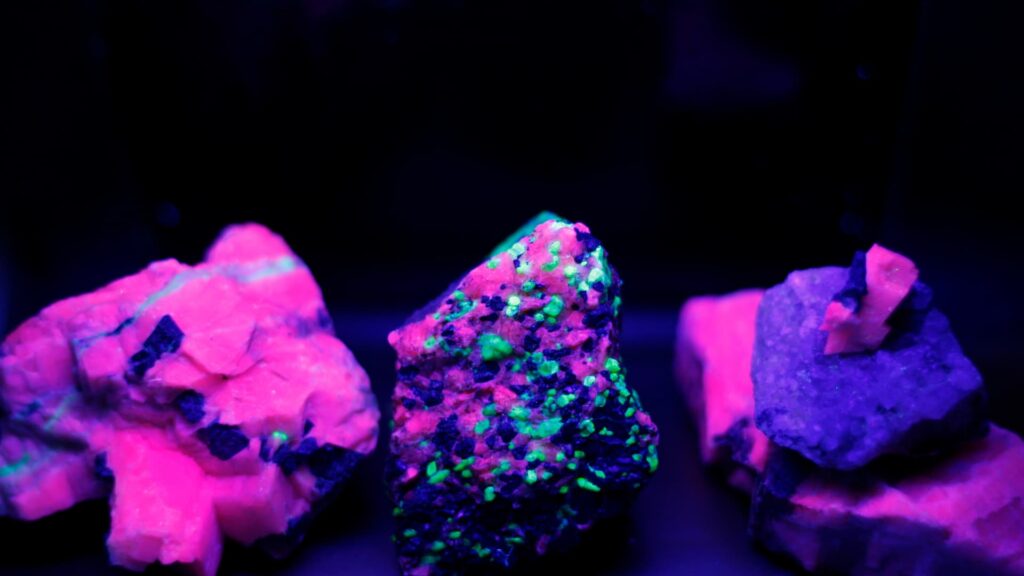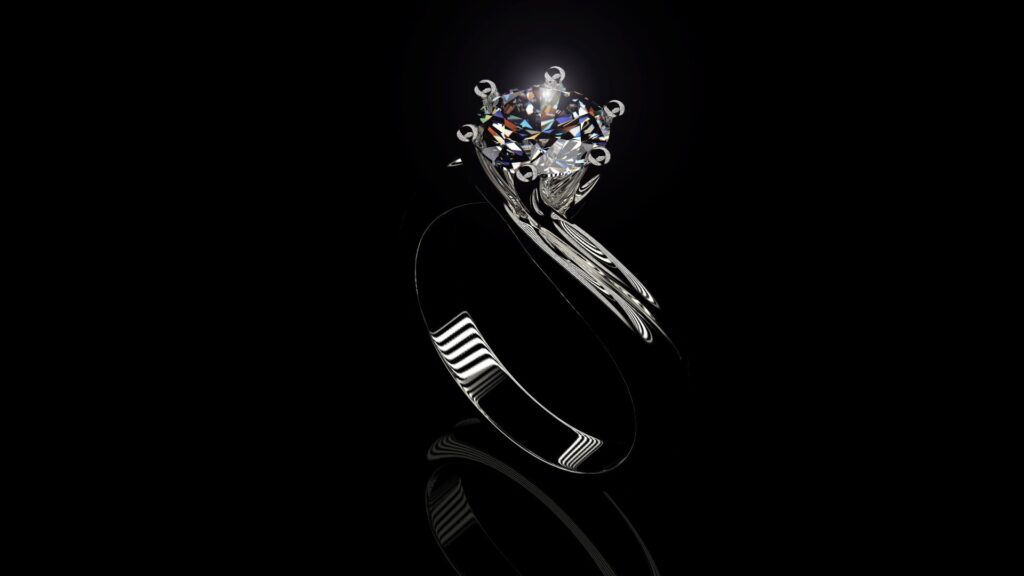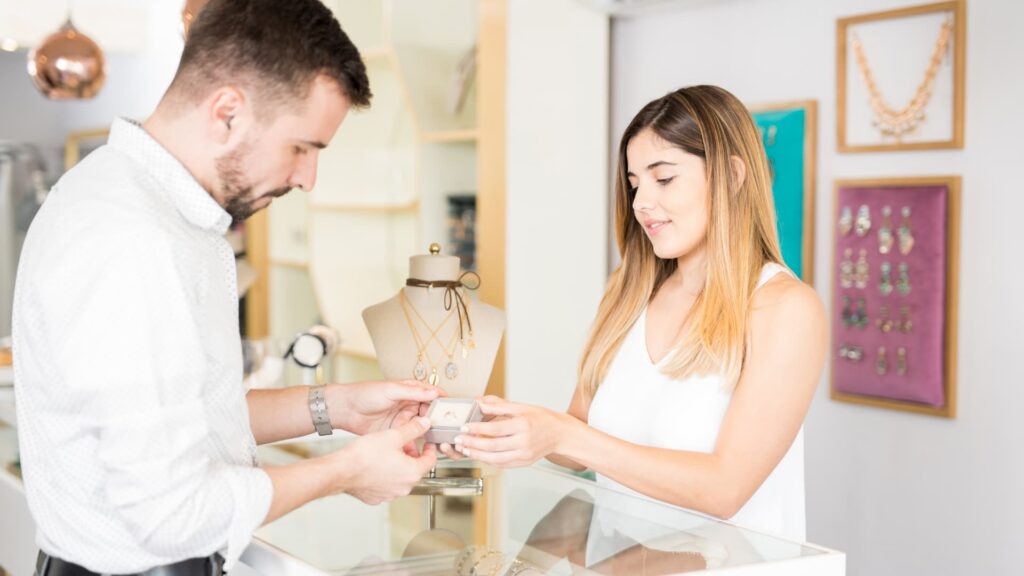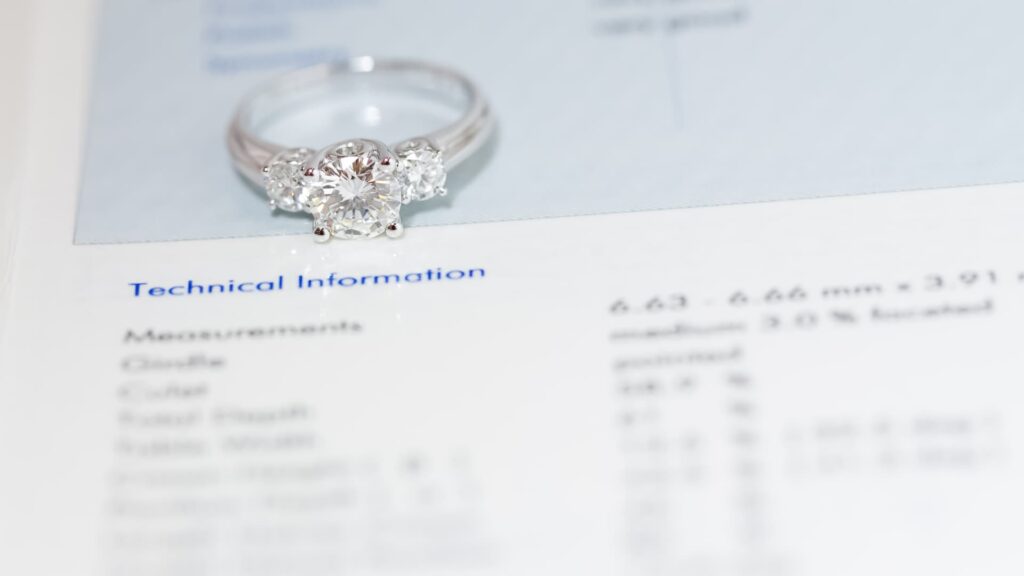Diamonds are formed when carbon deposits deep inside the earth are subjected to high pressure and temperature. But lab-grown diamonds are just like test-tube babies. A single seed of a diamond is treated with high pressure and temperature, just like a mined diamond.
These lab diamonds are almost 50 percent cheaper than naturally grown diamonds. So, people on a tighter budget who love to wear diamonds can buy lab-grown diamonds.
Luckily, lab diamonds exhibit similar physical and chemical characteristics as natural diamonds. An untrained eye can not distinguish the difference between a lab-grown and mined diamond. Reputed gemological laboratories like the Gemological Institute of America also grade lab-grown diamonds so that you can buy these diamonds without fear of being duped.
But what about glow-in-dark lab diamonds? Fluorescence in lab-grown diamonds is a property that will make them glow or emit light when exposed to UV light. Phosphorescence is another feature of Type 11 B lab-grown diamonds, which makes the diamond glow for a short time in the dark even after the ultraviolet lights are switched off.
Type 11 B lab-grown diamonds are nitrogen-free but instead contain Boron. Boron tends to soak in yellow, orange, and red light and results in diamonds emitting a faint blue or gray color in the dark.
Let us discuss these glow-in-dark lab diamonds and how to see phosphorescence in a diamond.

Fluorescence in Lab Diamonds
During the formation of natural diamonds, different traces of elements like Aluminum, Boron, and Nitrogen are trapped inside the crystal structure. These elements react to UV light and produce a glow effect or emit visible light.
Lab-grown diamonds are man-made diamonds. They are grown inside the lab mainly by two processes: HPHT (high-pressure and high temperature) and CVD (chemical vapor deposition) processes.
HPHT Process
The HPHT process begins when a small diamond seed is placed in carbon (usually graphite) and a metal flux mixture. It is subjected to a high temperature of 2,300 to 2,900 degrees Fahrenheit and a pressure of up to 59,200 atm.
The process melts the carbon and forms diamonds around the seed. The metal flux contains traces of nitrogen, cobalt, and boron that helps reduce the temperature during the diamond formation.
The heat treatment causes the carbon atoms to pair with traces of nitrogen or other elements. So, when a lab-grown diamond is exposed to ultraviolet light, it emits blue, red, or any other color. For instance, if traces of nitrogen are present in a lab-grown diamond, then it will emit a blue color in ultraviolet light.
What Is the Difference Between Fluorescent and Non-fluorescent Diamonds?
Fluorescence significantly impacts the look of lab-grown diamonds. A fluorescence lab-grown diamond will glow with different colors like blue, red, or others under an UV lamp, but a diamond without fluorescence will not emit any visible light.
Similarly, the sun’s ultraviolet rays can make the fluorescent lab-grown diamond glow or change color, which will change the appearance of the diamond you wear on your finger.
The color of the fluorescence plays a vital role in the overall appearance of the diamond — nearly 95 percent of fluorescent lab-grown diamonds exhibit blue color when exposed to UV light. However, some diamonds can also display red, yellow, or other colors like orange.
Some people believe that fluorescence in a lab-grown diamond will give a hazy or milky look. That’s true, but only if the lab-grown diamond has strong fluorescence.
Related article: Your Guide to Cloudy Diamond Rings
Florescence does affect the sparkle or clarity of the diamond. So, if you want to purchase a diamond with some sparkle, you should consider its fluorescence.
The diamond’s cut plays a vital role in the shine of the diamond. When the diamond cut is excellent, it will reflect all the light passing through the facets, which enhances the diamond’s sparkle and brilliance.
How Does Fluorescence Impact a Lab-Grown Diamond?
According to GIA studies, most diamond buyers cannot detect the difference between fluorescent and non-fluorescent diamonds just by observation.
The Gemological Institute of America has graded fluorescence as an identifying characteristic of a diamond. But it is not considered a grading factor like the 4Cs.
The GIA grades fluorescence as none, faint, medium, strong, and very strong on their diamond certificate.
1. None
The lab-grown diamond has no fluorescence.
2. Faint
If you purchase a lab-grown diamond with faint fluorescence, you will not notice any haziness or cloudiness. It may improve the color of your precious stone.
3. Medium
A lab-grown diamond with medium fluorescence can overall make the look of the diamond brighter or improve its visible color. For instance, a lab-grown diamond with a K color grade having medium fluorescence will have slight yellow tints.
Blue fluorescence will cancel the yellow tints, and the diamond will appear colorless in UV light. The K color grade lab-grown diamond will look like G or H color grade, and it will have a colorless appearance.
However, medium fluorescence can have the opposite effect if you intend to purchase a diamond with a color grading of D to F.
4. Strong-Or Extremely Strong
Lab-grown diamonds with strong fluorescence will have a hazy or cloudy look under UV light.
Read also: Diamond Looks Blue In Sunlight: The Mysterious Blue Glow
How to See Phosphorescence in Lab-Grown Diamonds
Phosphorescence is the afterglow effect that means your lab-grown diamond will emit visible light for a few seconds even after the UV lights are shut off.
Phosphorescence is not the same as fluorescence, although they are related. A high-pressure, high-temperature lab-grown diamond may not have fluorescence but may still have phosphorescence.
For instance, if you intend to purchase a lab-grown diamond that produces a blue hue in UV light, then that does not mean it will produce phosphorescence after shutting down the UV light.
Similarly, if the diamond you want to buy is a lab-grown diamond with no fluorescence, it may have phosphorescence. A high-pressure, high-temperature lab-grown diamond will have strong phosphorescence when exposed to short wave ultraviolet light.
You can see phosphorescence in lab-grown diamonds if you place them immediately in darkness after exposure to direct sunlight. So, you don’t need any gemological tool to check the phosphorescence of a lab-grown diamond.
Reputed entities like the Gemological Institute of America or the Gem Certification and Assurance lab do not grade and don’t check the phosphorescence of lab-grown or earthed diamonds.
Related article: GCAL vs. GIA – What Is the Best Diamond Certification?
You need to check the diamond yourself or accept the help of a gemologist to find out whether the lab-grown diamond has phosphorescence or not.
Also read: Lab-grown Diamonds Vs Real Diamonds
Final Thoughts
Fluorescence and phosphorescence have a significant impact on the color and appearance of the lab-grown diamond. If you intend to purchase a lab-grown diamond that will glow in the dark, check the phosphorescence by moving suddenly from UV light to dark.
Again for fluorescence, you can check the diamond certificate. Reputed gemological labs indicate the type of fluorescence in a diamond on their certificates.
You might not want to buy a lab-grown diamond with strong or very strong fluorescence as it may look too milky or hazy for your liking.
Related article: Do Diamonds Glow Under Black Light?






